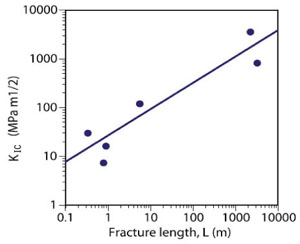| |||||||
|
|
|||||||
|
|
|||||||
| Joint Aperture - Length Scaling | |||||||
|
Attempts have been made to measure aperture as reflected by thickness of infilling of opening mode structures of various kinds (joints, veins, and dikes) to establish a maximum displacement discontinuity-length relationship (Figure 1) (Olson, 2003; Schultz et al., 2008). These authors concluded that opening mode structures have a displacement-length scaling relationship which is consistent with an exponent from 0.5 to 1.0, with Schultz et al. (2008) favoring the square root relationship. On the other hand, Scholz (2010) based on almost the same data set (except one minor addition which appears to be inconsequential for the interpretation) concluded that the data set fits better to a linear trend and thus, the scaling law is consistent with the premise of linear elastic fracture mechanics (Figure 2) which predicts that the critical stress intensity factor scales with the square root of length (KIC ~ (L)1/2) and the maximum aperture or displacement discontinuity scales linearly with the length (dm ~ L). Evidently, there is no agreement on the issue. As we will discuss under the statistical properties of faults, combining data from different scales in different rocks and collected by various workers introduces somewhat different problems. The properties of rocks including their vertical and lateral anisotropy change. It is not just the differences in moduli but the anisotropy introduced by the change of moduli may be more significant for fracture propagation and termination. Each data set was collected by different workers with differing accuracy and philosophy. Finally, last but not least, the nature of interaction between networks of structures such as veins or joints which probably developed together and dikes which probably formed individually may be problematic. It appears that many investigators are aware of the fact that most if not all fractures are segmented at various scales. Some of these segments may merge into a single entity at depth but this is not a unique interpretation. Most investigators also know that neighboring segments interact thereby influencing the dimensions of the individual structures and of the entire array. It suffices to conclude that knowing something is not necessarily the same as accounting for it in the surveys and analyses. | |||||||
| Reference: |
|||||||
| Lachenbruch, A.H., 1962 Olson, J., 2003 Scholz, C.H., 2010 Schultz, R.A., Soliva, R., Fossen, H., Okubo, C.H., Reeves, D.M., 2008 |
|||||||
|
Readme | About Us | Acknowledgement | How to Cite | Terms of Use | Ⓒ Rock Fracture Knowledgebase |
|||||||

